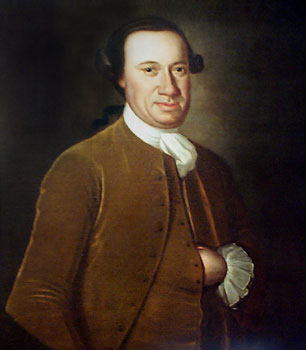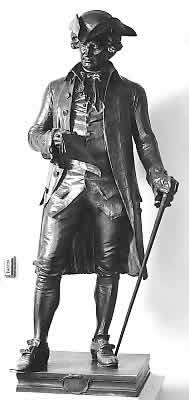<Back to Index>
- Philosopher Moritz Schlick, 1882
- Painter Victor Elpidiforovich Borisov-Musatov, 1870
- President of the Continental Congress John Hanson, 1721
PAGE SPONSOR


John Hanson (April 14 [O.S. April 3] 1721 – November 22, 1783) was a merchant and public official from Maryland during the era of the American Revolution. After serving in a variety of roles for the Patriot cause in Maryland, in 1779 Hanson was elected as a delegate to the Continental Congress. He signed the Articles of Confederation in 1781 after Maryland finally joined the other states in ratifying them. In November 1781, he became the first President of Congress to be elected under the terms of the Articles of Confederation. Because of this, some people claimed that he was the first President of the United States.
John Hanson, Jr. was born at "Mulberry Grove" in Port Tobacco Parish in Charles County in the British Province of Maryland. The American National Biography lists Hanson's birth date as April 3, 1721, which in the modern calendar system is equivalent to April 14, although the older Dictionary of American Biography gives the date as April 13, 1721. Some older sources list a birth year of 1715. Hanson's parents were Samuel and Elizabeth (Story) Hanson. Samuel Hanson was a planter who owned more than 1,000 acres (4.0 km2), and held a variety of political offices, including serving two terms in the Maryland General Assembly. John Hanson was of English ancestry; his grandfather, also named John, came to Charles County, Maryland, as an indentured servant around 1661. In 1876, a writer named George Hanson placed John Hanson in his family tree of Swedish Americans descended from four Swedish brothers who emigrated to New Sweden in 1642. This story was often repeated over the next century, but scholarly research in the late 20th century suggested that John Hanson was of English heritage and not related to these Swedish American Hansons.
Hanson
had no extended formal education while growing up in Maryland, but he
read broadly in both English and Latin. He followed the family
tradition as a planter, extending and improving his holdings. About
1744 he married Jane Contee, with whom he would have eight children. Their son Alexander
Contee
Hanson, Sr. (1749
– 1806)
was
a notable essayist. Alexander Hanson is
sometimes confused with his son, Alexander
Contee
Hanson, Jr., who became a newspaper editor and US
Senator. Hanson's
career in public service began in 1750, when he was appointed sheriff
of Charles County. In 1757
he was elected to
represent Charles County in the lower house of the Maryland General
Assembly, where he served over the next twelve years, sitting on many
important committees. Maryland
was a proprietary
colony, and Hanson aligned himself with the "popular" or
"country" party, which opposed any expansion of the power of the
proprietary
governors at the expense of the popularly elected lower house. He was a
leading opponent of the 1765
Stamp
Act, chairing the committee that drafted the instructions for
Maryland's delegates to the Stamp
Act
Congress. In protest of the Townshend
Acts, in 1769 Hanson was one of the signers of a nonimportation
resolution that boycotted British imports until the acts were repealed. Hanson
changed course in 1769, apparently to better pursue his business
interests. He resigned from the General Assembly, sold his land in
Charles County, and moved to Frederick
County in western
Maryland. There he held a variety of offices, including deputy
surveyor, sheriff, and county treasurer. When
relations between Great Britain and the colonies became a crisis in
1774, Hanson became one of Frederick County's leading Patriots.
He
chaired
a town meeting that passed a resolution opposing the Boston
Port
Act. In 1775, he was a delegate to
the Maryland
Convention, an extralegal body convened after the colonial
assembly
had been prorogued.
With
the
other delegates, he signed the Association of Freemen on July
26, 1775, which expressed hope for reconciliation with Great Britain,
but also called for military resistance to enforcement of the Coercive
Acts. With
hostilities underway, Hanson chaired the Frederick County committee
of
observation, part of the Patriot organization that assumed
control of local governance. Responsible for recruiting and arming
soldiers, Hanson proved to be an excellent organizer, and Frederick
County sent the first southern troops to join George
Washington's army. Hanson
was elected to the newly reformed Maryland
House
of Delegates in
1777, the first of five annual terms. In December 1779, the House
of Delegates named Hanson as one of its delegates to the Second
Continental
Congress. He began those duties when he took his seat in Philadelphia on June 14, 1780, serving
until 1782. While Hanson was in Congress, the Articles
of Confederation were
at
last ratified by all the states. When the Congress received notice
of this on March 1, 1781, he joined
Daniel Carroll in
endorsing them for Maryland. In
November 1781, Hanson became the first President
of
Congress to be
elected for an annual term as specified in the Articles of
Confederation, although Samuel
Huntington and Thomas
McKean had
served
in that office after the ratification of the Articles. Under the
Articles of Confederation, the United States had no executive branch;
the President of Congress was a mostly ceremonial position within the Confederation
Congress, but the office did require Hanson to handle a good
deal
of correspondence and sign official documents. Hanson found the work
tedious and wished to resign, but his departure would have left
Congress without a quorum to select a successor, and
so, out of a sense of duty, he remained in office. Because
Hanson was the first president under the Articles of Confederation, one
of his grandsons later promoted him as the first President of the
United States. This ultimately resulted in Hanson's statue being one of
two representing Maryland in Statuary Hall in the U.S.
Capitol, even though, according to historian Gregory Stiverson, Hanson
was not one of Maryland's foremost leaders of the Revolutionary era. The claim that Hanson was
the forgotten first President of the United States was further promoted
in an 1932 biography of Hanson by journalist Seymour Wemyss Smith. Smith's book, which
contained no footnotes or references, made expansive claims about
Hanson's role, asserting that the American Revolution had two primary
leaders: George Washington in the military sphere, and John Hanson in
politics. Hanson
retired from public office after his one-year term as President of
Congress. In poor health, he died a year later at his nephew's
plantation Oxon
Hill
Manor in Prince
George's
County, Maryland, on November 22, 1783. The grave site is lost. Maryland
law specifies that "the Governor annually shall proclaim April 13 as
John Hanson's birthday and dedicate that day to the statesman." Also, the John
Hanson
Highway is
named in his honor. There are also middle schools located in Oxon
Hill, Maryland, and Waldorf,
Maryland, named after him. A former savings bank named for him
was
merged in the 1990s with Industrial Bank of Washington,
DC. A namesake, John Hanson Briscoe, was a circuit judge and
Speaker of the Maryland House of Delegates. In 1903
the state of Maryland donated a bronze statue by Richard
E.
Brooks to the United
States
Capitol's National
Statuary
Hall Collection. It is currently located on the 2nd floor
of the Senate connecting corridor. A maquette of the Hanson statue by
Brooks resides on the President's dais in the Senate Chamber of the
Maryland State House.